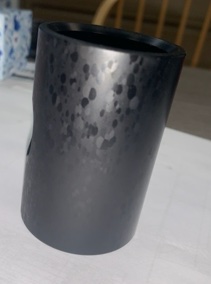
Curated with aloha by
Ted Mooney, P.E. RET

The authoritative public forum
for Metal Finishing 1989-2025

-----
Is Discoloration an Etching Problem?
Q. I ran parts that were hard coat up to 2.5 mils and dyed black. There is this spotty and patchiness to the parts.

I am wondering if this is from the etch and what would be the cause of it?
Jordan- Pennsylvania
September 19, 2024
Tip: This forum was established to build camaraderie among enthusiasts through sharing tips, opinions, pics & personality.
The curator & some readers who publicly share their info will be less likely to engage with those who don't.
A. Jordan
Consider looking at thread 30670 for additional guidance.
Etching contributes to the issue.
- Green Mountain Falls, Colorado
September 27, 2024
A. It is clearly a material issue. The microstructure is visible and granular in structure, probably coarse-grained. In the case of extruded material, the problem is often only on the surface.
Joerg Beerli- Hallau, Switzerland
October 9, 2024
A. Hello Jordan
This is, without a doubt, what is typically called "Coarse Grain Structure", I've seen it being called mottling and marbling as well.
There are several highly technical documents out there on the great world wide web that goes into the very details of what causes it.
Typically you cannot see it on the raw material, especially not when it is machined. But even just a slight bit of etching tends to bring it out clear as day, just like you see it on your part. The issue is, that more etching isn't a solution unless you can etch several mil into the material.
In essence, the cause of it is during the extrusion process of the material. Due to the shape of such, there usually ends up being a corner-like structure inside the extrusion tube where the material is heated to go through the shaping form. All the contaminated aluminium from the outer shell of the billet builds up there and the shorter the billet gets and the more all the contaminants build up, the more likely you are to be seeing this, as it slowly gets pressed into the extrusion due to a lack of material elsewhere. Then during the cooling down process, the material cools off at different rates due to contaminants and that is what, in part, causes this structure. We've fought far too many times with extrusion plants over this, for it to be funny.
At least that is my understanding with a limited metalLurgical education. If you feel up for knowing more, this link may offer some educational value to you:
https://medium.com/@mtapas/coarse-grain-in-aluminium-extrusion-remedial-measures-c43ebbb1b6ac
Also, unless you know some black anodizing magic, there is nothing to do, at the point where you are at. So if your client or you, cannot use it as is. It's gonna be a new part I'm afraid.
Of course, if you are allowed to do a rework, to try and at least lessen the effect, glass blasting has proven here to at least hide it a little.
I'm sorry that the news aren't better. But I hope that you will never have to face such again, as it can be difficult to fight extruders on this, even if you can tell them exactly what the issue is.
Production Technician - Horsens, Denmark
A. I have only seen this phenomenon on extruded parts. I believe it is a heat treating issue integral to the extrusion process . Try stripping the part and then re-heat treat in a batch process, then re-hardcoat.
Chris Jurey, Past-President IHAALuke Engineering & Mfg. Co. Inc.
Wadsworth, Ohio

Q, A, or Comment on THIS thread -or- Start a NEW Thread